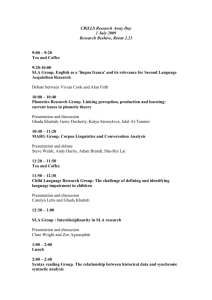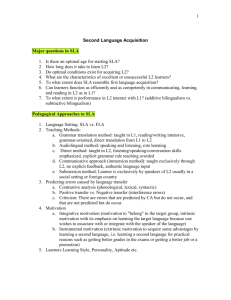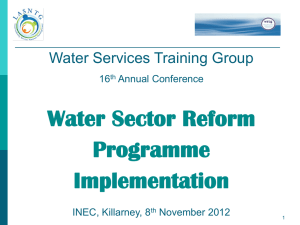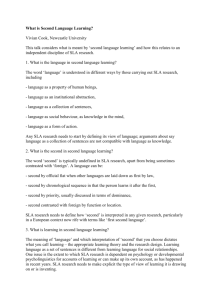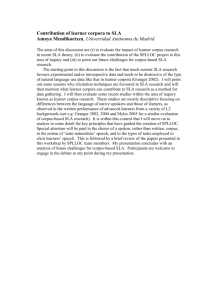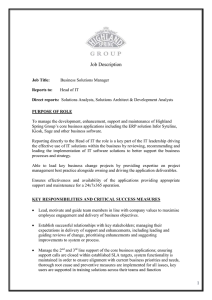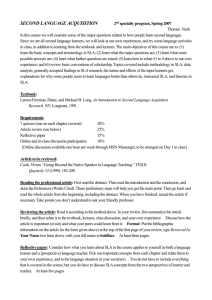Principles and Process presentation (Powerpoint, 3.9M)
advertisement
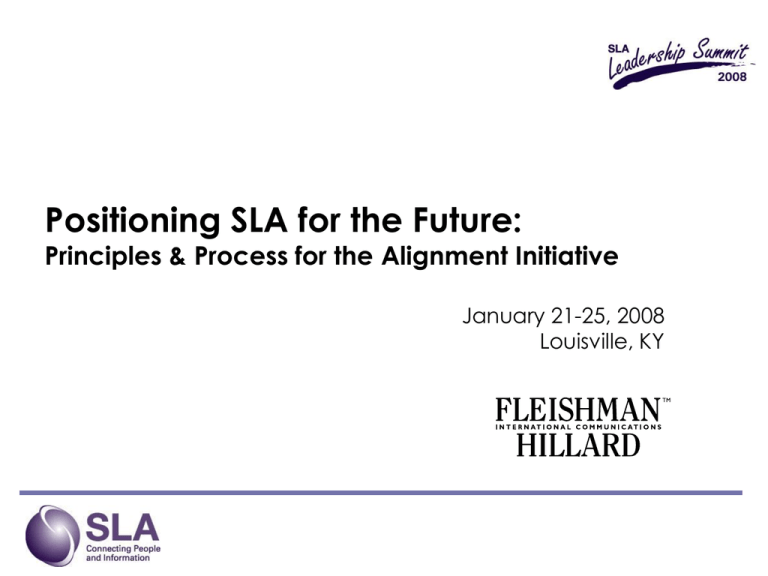
Positioning SLA for the Future: Principles & Process for the Alignment Initiative January 21-25, 2008 Louisville, KY Principles of Alignment “Companies that enjoy enduring success have core values and a core purpose that remain fixed while their business strategies and practices endlessly adapt to a changing world.” – Collins & Porras Principles of Alignment Alignment is a discipline for thinking, communicating and behaving as one enterprise connected by a unified mission • Focus and cohesion to drive organizational outcomes • Who you are, what you stand for, what you deliver • Clarity, Credibility, Consistency Alignment from the inside-out: mission, vision, values • The essential truth of the organization and profession • The fundamental idea – core purpose, ethos and values; essential truth of being • A promise of value that builds a relationship with stakeholders, securing preference, loyalty and trust • A position that is relevant, differentiated and credible Principles of Alignment Elements of Organizational Identity • Identity: The unique characteristics of an organization that defines its value-creating potential • Personality: The attributes of the organization that inform how it communicates and behaves • Positioning: The promise that an organization makes that shapes its relationship with all stakeholders, based upon its identity and personality Identity + Personality = Positioning Principles of Alignment Positioning Statement: AARP is the leading membership organization that champions positive social change through information, advocacy, philanthropy, products and community service to enrich people’s lives as they age – today and for generations to come. Principles of Alignment Visual identity & materials integrating key messages Principles of Alignment How communication of core identity works The Landscape: Membership Membership growth is a priority • Decline of boomers in the global workforce has impacted membership numbers • Perception exists that librarians and information professionals are no longer needed • Gen-Xers, Gen-Yers and Millennials are exhibiting a declining rate of membership affiliation • Increased focus on recruiting and retaining younger members and members outside of North America • Increased opportunities among individuals in second careers and adjacent career tracks (e.g. competitive intelligence and knowledge management) The Landscape: Technology Sweeping technological changes are challenging the role and perceived value of information professionals • Value-added intelligence is not a widely known or appreciated concept • Many business leaders think that consumer search engines like Google are all they need • Speed, convenience and self-service are gaining momentum The Landscape: Opportunity SLA has an opportunity to position itself as the premier association for a broad range of information professionals • Opportunities to highlight the value of librarians and information professionals to senior executives • As the roles and responsibilities of information professionals continue to evolve, SLA has the opportunity to be at the forefront and foundation of the field • Opportunities to expand membership beyond traditional library workers and information professionals • Opportunities to reach new audiences through graduate and undergraduate library and information management programs The Landscape: Key Milestone The SLA Centennial in 2009 and its prelude provide unique opportunities • Opportunity to establish a shared vision of the future and the role of information professionals in it • Opportunity to establish clarity and unity around SLA’s and the profession’s core purpose, ethos and value, including defining an institutional positioning that is relevant, differentiated and deliverable Key Objectives • Examine: Conduct thorough examination of the future roles of librarians and information professionals in a new and evolving information landscape • Explore: Explore current position in the marketplace and define a platform –based on sound scientific research – that is relevant, differentiated and deliverable and will stand the test of time • Develop: Develop a strategic framework that underscores SLA’s value for existing members and enables outreach to a broad spectrum of information professionals Key Objectives • Align: Bring alignment to SLA’s diverse activities through a relevant and compelling platform that expresses core values of the Association and the profession as a whole • Identify: Identify the programs, tools, language and materials that uniquely express and amplify SLA’s positioning to members, employers, partners, regulators and the public, and highlight the value of information professionals in today’s information economy The Process Define: Audit Existing Resources Fleishman Hillard conducted a review of existing information, research and supplemental resources provided by SLA, including: • Interviews with SLA leadership and membership • Task Force reports • Member and board profiles • Existing surveys (i.e. Exhibitor Surveys, Attendee Surveys, Information Outlook surveys, Peer-Reviewed Journal Survey, Board Survey and Member Surveys, etc.) Define: Audit Existing Resources Fleishman Hillard conducted supplemental research including: • Review of SLA’s current communication framework • Scan of media coverage in mainstream outlets and trade publications over the last 18 months • Audit of blog and online editorial coverage • Audit of competitor communications, messages, positioning and member offerings • Inventory of key terms and descriptors for the information profession • Analysis of target audience perceptions using existing research from Outsell and Social Technologies Define: Strategic Issues Information and research audit indicates several key strategic issues to be addressed, including: • Core values of information profession—detail, depth, thoroughness—are not aligned with customers who seek speed and convenience, often at the expense of accuracy • Instead of functional descriptors, librarians and information professionals need to be defined in terms of the value, benefit and impact provided to their organizations (e.g. advancing business development, facilitating good decision-making, managing crises, etc.) • Messages that validate strategic ROI of library and information management professionals need to be more actively promoted Define: Strategic Issues Key Findings (cont.): • SLA’s positioning must cut across multiple dimensions within the broader librarian-and-information professional category • SLA’s diverse membership base and membership targets will require tailored communication strategies as well as overarching positioning • SLA’s competition for membership, services and market leadership has intensified and diversified • SLA’s current communication framework and visual identity need greater alignment, structure and consistency Define: Strategic Issues Key Findings (cont.): • Formal mechanisms are needed to ensure all extensions of SLA are thinking, communicating and behaving as one enterprise Define: Strategic Issues Feedback from board members and key influencers suggests a framework that focuses on five key areas: 1. Growth opportunities for SLA and the profession as a whole 2. Priority activities to drive and sustain membership 3. Role and growth of SLA outside North America 4. Key value drivers for the profession and the Association 5. Consistent and compelling language to describe the profession and the Association Define: Knowledge Gaps Where are the gaps? Feedback is required from the following target audiences for future growth: • CEOs and senior executives of global IP employer organizations • Younger audiences already in the profession • Professionals in adjacent career tracks where information management plays a key role (i.e. medical research, analysts, mergers and acquisitions) • Students and faculty in library science programs Define: Knowledge Gaps What do we need to know? Input that will inform a positioning framework for SLA, including: • Benefits and essential value that cut across all dimensions of special librarianship (ROI research) • Perceptions around information technology, either as a tool or a competitor • Outsourcing trends and the impact on the profession • New, emerging career tracks • Emerging business models and functional domains • Skill sets/core competencies today and tomorrow • Labels, terms, and language to describe the information management profession, information professionals and their value Define: Knowledge Gaps What do we need to know? Input that facilitates membership recruitment, including: • Key psychological factors that create an emotional connection with SLA • Key products, services, programs, and areas of advocacy • Key factors that best meet the needs of the varied segments of the profession (i.e. multiple chapters, alliances, geographic breakdown, etc.) • Key factors that best meet the needs and support the aspirations of students or entry-level professionals Define: Knowledge Gaps What do we need to know? Trend research (Social Technologies and Outsell) that can inform the alignment and positioning process, including: • Cultural flows • Gen Y information behaviors and preferences and impact on the profession • General work trends • General outsourcing trends • General technology trends Define: Knowledge Gaps How do we close the gap? Analyze best data available from multiple sources, including: • SLA membership studies • Outsell studies on the Information Profession • Social Technologies studies on future trends Outcomes of analysis will yield essential ingredients for primary research and positioning exercises, including: • Segmentation, sample plan, survey design for primary research • Draft language that effectively positions the information profession based on relevant research and analysis Define: Knowledge Gaps Outsell Data Assets • Surveys of information users & decision makers in enterprises since 1998: 15,000 per year • Annual benchmark surveys of information managers since 1999: 600+ per year • Hundreds of custom needs assessments/surveys and interviews with users and stakeholders • 7,000+ information companies’ market size, share, forecasts Define: Primary Research Input from SLA and Outsell research will inform the development of a Web-based survey that: • Obtains information from target audiences specific to SLA membership recruitment and retention • Obtains quantitative and qualitative feedback (using Interactive Editor) to develop a framework that positions SLA and the industry for future growth Define: Primary Research Interactive Editor • Respondents can rate the appeal of key words and phrases • Provides a truly interactive concept testing experience • Quantifies how compelling your language is before you go to market Define: Primary Research Interactive Editor Most Appealing • Identifies concept strengths and weaknesses • Benefit 1 • Support 1 Intensity of Appeal • Rates products/services along intensity of appeal and frequency of mention • Logo • Support 2 • Brand Tagline Least Appealing Frequency of Mention • Claim Translate: Message Exploration Step 1: Aggregate data from Outsell, Social Technologies, and primary research to develop language around: • Positioning statements • Taglines • Organizational mission, vision, values Step 2: Taped Q&A sessions of key influencers and new messages to: • Identify common points of positioning among different explanations of profession and SLA • Demonstrate how target audiences react to key influencers • Measure current language against new language Translate: Message Testing Step 3: Conduct two Instant Response Dial Sessions to: • Identify immediately which messages are promising and which should never be used again. • Provide accurate measure to determine exactly what works, what doesn’t and why. Translate: Message Testing What is Instant Response? •Combines the most important components of quantitative, qualitative and in-depth public opinion research to test message delivery, understanding, believability and impact. •A computer-based system, the IR dial displays secondto-second measurement of participant reaction to any verbal communication. Translate: Message Testing Instant Response Sessions • Data from the Instant Response dial sessions are displayed as computer generated, continuous lines superimposed on the screen. • The video will illustrate the messages that work – and those that do not. Translate: Message Testing Instant Response vs. Focus Group Instant Response Focus Group • Allows for testing of long-form • Tests limited amounts of pre- • Provides detailed feedback on • Provides general impressions of • Allows for testing of multiple • Uses written presentations of messaging • Allows for refinement and crafting of new language to address target market reactions exactly which words and phrases resonate, which don’t, and why. approaches from actual information professionals determined language. words and concepts language Translate: Platform & Positioning Outcomes of research, analysis and positioning exercises will provide the optimal language to: • Build a platform that unites key programs, resources, products and services, and cultivates and promotes relationships with key audiences • Build a platform that stands the test of time and remains relevant to librarians, information professionals, their employees and industry partners • Articulate a common vision, identity and core purpose— mission and vision statements, a formal definition of the profession and SLA, and tailored positioning statements • Create a framework for the development of communication materials that enables consistent application of key messages through all SLA programs and services Positioning SLA for the Future: Principles & Process for the Alignment Initiative January 21-25, 2008 Louisville, KY
